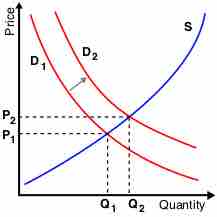The interdependent relationship between the supply of a given product or service and the overall demand exercised by interested parties generates a theoretical equilibrium point, dictating the average market price and purchased volume relative to that price. In a static market it would be reasonable to assume that prices and volumes would remain fairly predictable and consistent relative to the population, but realistic markets are not static. Instead, markets are in constant flux as demands and supplies are subjected to varying driving forces and influences. These shifts play a critical role in altering market equilibrium price points and volumes for products and services, requiring constant vigilance and adaptation by providers and consumers. In understanding this further it is useful to examine how changes in supply and demand may occur, and what the impacts and implications are of these changes.
Demand Shifts
Demand shifts are defined by more or less of a given product or service being required at a fixed price, resulting in a shift of both price and quantity. As would be assumed, an increase in demand will shift price upwards and volume to the right, increasing the overall value of both metrics relative to the prior equilibrium point . Alternately, a decrease in demand will shift price downwards and volume to the left, decreasing both measurements to realign equilibrium with a reduced demand.

Demand Shifts
In this graph, the demand curve (red) has been affected by an increase in demand. This consequently increases price at a given volume.
Demand shifts can be caused by a wide variety of factors, but largely revolve around drivers of consumer behavior and circumstances. Demand shifts can therefore often be affected by economic factors such as average spending power per person in a given economy or overall average income. Demand can also be affected by cultural changes, demographic shifts, availability of substitutes, environmental factors and concerns (e.g. climate change), politics, and advances in science (e.g. declining demand for unhealthy foods). Demand is particularly malleable in respect to goods that are not necessities, thus are desired or not based upon sociological norms.
Supply Shifts
Supply shifts are defined by more or less of a particular product/service being available to fulfill a given demand, affecting the equilibrium point by shifting the supply curve upwards or downwards. A supply shift to the right, indicating more availability of the specified product or service, will create a lower price point and a higher volume assuming a fixed demand . Alternately, a decrease in supply with a consistent given demand will see an increase in price and a decrease in quantity. This is an intuitive theory underlining the fact that scarcity is relevant to the willingness to pay.

Supply Shifts
In this supply and demand chart we see an increase in the supply provided, shifting quantity to the right and price down. More of a given product, assuming the same demand, will result in lower price points at the equilibrium.
Supply shifts, similar to demand shifts, can ultimately be a result of a wide variety of external factors. As discussed above, scarcity plays a critical role in pricing and thus controlling supply is often even considered a strategic play by companies in specific industries (most notably industries like precious stones, rare earth metals, etc.). Supply shifts can also be a result of technological advances, over-utilization or consumption, globalization, supply-chain efficiency, and economics. For example, the discovery of a new gold deposit, acts as a shock to the supply of gold, shifting the curve right.
Equilibrium
In combining these two potential shifts, equilibrium is constantly subjected to both factors resulting in supply shifts and factors resulting in demand shifts. Due to the demand curve sloping downward and the supply curve sloping upwards, they inadvertently will cross at some given point on any supply/demand chart. This cross-section, or equilibrium, serves as a price and quantity tracking point based upon the consistent inputs of overall demand and supply availability. Any change in either factor will result in immediate impact on equilibrium, balancing the new demand or supply with a corresponding volume and appropriate average price point.